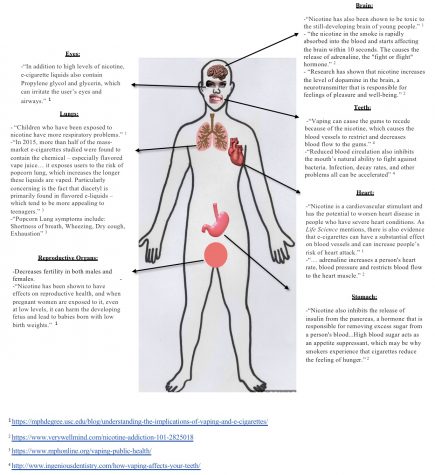Vaping Hazards
“The amount of young adults who use e-cigarettes increased from 2.4 percent in 2012 – 2013 to 5.2 percent in 2015,”Truth Initiative, a organization, stated. Photo Courtesy of Pixabay
March 22, 2019
“America’s teens report a dramatic increase in their use of vaping devices in just a single year, with 37.3 percent of 12th graders reporting any vaping in the past 12 months, compared to just 27.8 percent in 2017,” The National Institute on Drug Abuse states from findings in the 2018 Monitoring the Future survey of a nationwide representative sample of 8th, 10th and 12th graders in schools nationwide.
Vaping is the act of inhaling and exhaling aerosol referred to as vapor which is produced by an e-cigarette or similar device. These devices contain toxic chemicals that have been linked to mental and physical health problems.
Additionally, Get Smart about Drugs, a United States Government, Drug Enforcement Administration (DEA) website which informs parents, educators and caregivers about drugs states on their website that, “13.1 percent of 12th graders reported vaping marijuana within the past year — an increase from the 9.5 percent in 2017.” If all trends remain the same, this means that by 2022 the percentage of 12 graders vaping marijuana could be as high as 34.4%.
According to the National Institute on Drug Abuse, manufacturers don’t have to report e-cigarette ingredients, so users don’t know what’s actually in them.
“A recent study found that 98.7 percent of all e-cigarette products sold at convenience stores, supermarkets and similar outlets contain nicotine. Yet, many young people aren’t aware that the products they use contain nicotine. In fact, 60 percent of teens incorrectly reported e-cigarettes as being comprised of mostly flavoring,” Truth Initiative said.
Although, vaping has been around since the 1930s and was introduced to the United States in 2006, a spike in its usage has been seen in the past couple of years, especially in teens.
“The usage of e-cigarettes in the past month was 9.5% among 8th graders, 14% among 10th graders, and 16.2% among 12th graders,” stated the National Institute on Drug Abuse.
Truth Initiative shares an infographic showing the change in e-cigarettes, 0.6% of middle school students and 1.5% of high school students used e-cigarettes in 2011. That increased to 3.3% of middle school students and 11.7 of high school students using e-cigarettes in 2017.
Vaping mentally affects a teen by causing mental changes such as affecting the centers of development of attention and learning brain circuits.. They also cause mood disorders and impulse controls problems for teens that still have developing brains.
“The part of the brain that’s responsible for decision making and impulse control is not yet fully developed during adolescence. Young people are more likely to take risks with their health and safety, including use of nicotine and other drugs. Youth and young adults are also uniquely at risk for long-term, long-lasting effects of exposing their developing brains to nicotine. Nicotine also changes the way synapses are formed, which can harm the parts of the brain that control attention and learning,”as stated on the U.S. Surgeon General government website.
Vaping is linked to cancer, respiratory issues and heart disease. The chemicals, formaldehyde, nitrosamines, and lead all are associated with health problems. The American Cancer society lists formaldehyde and nitrosamines generally as cancer causing chemicals.
“Lead poisoning can lead to a variety of health problems in kids, including: decreased bone and muscle growth poor muscle coordination, damage to the nervous system, kidneys, and/or hearing, speech and language problems, developmental delay, seizures and unconsciousness (in cases of extremely high lead levels),” Kids Health Nemours, a non-profit children’s health system reported..
Nicotine is another chemical found, in a highly concentrated form, in vaping liquids which has many adverse side effects on the human body like nausea, chest pain, uneven heartbeats, seizures, weakness, swelling, and severe rashes. Nicotine is also a chemical found in tobacco which is found in cigarettes and cigars.
“My experience is that … it’s another form of addiction … There are some people that would only smoke if they went to a party and you [have] other people who … need that, it’s a dependency, their body has gotten used to it and it’s become a addiction,” Emergency Medical Technician and 9th grade Dean Drew Calvo said.
“The nicotine in e-liquids is readily absorbed from the lungs into the bloodstream when a person uses an e-cigarette. Upon entering the blood, nicotine stimulates the adrenal glands to release the hormone epinephrine (adrenaline). Epinephrine stimulates the central nervous system and increases blood pressure, breathing, and heart rate,” The National Institute of Drug Abuse states.

Nicotine is also an addictive drug that is caused by the release of dopamine, one of these neurotransmitters, is released into the “reward center” of the brain and then causes an improved mood and feelings of pleasure in the person making the person want to vape again and again to reach that same high they got the first time.
“So, it’s tough … , It’s like [a person] really gets addicted to this stuff and [they] can’t stop,” 9th Grade Dean Calvo said.
Nicotine addiction is not being able to stop using nicotine no matter what instead of stopping the person incorporates it so much in their life that it becomes difficult to do or think about anything else.
“Signs that you may be addicted [to nicotine] include:[a person] can’t stop smoking. [They’ve] made one or more serious, but unsuccessful, attempts to stop.[They] experience withdrawal symptoms when [they] try to stop. [Their] attempts at stopping have caused physical and mood-related symptoms, such as strong cravings, anxiety, irritability, restlessness, difficulty concentrating, depressed mood, frustration, anger…[They] keep smoking despite health problems…[They] give up social or recreational activities in order to smoke. [They] may stop going to smoke-free restaurants or stop socializing with certain family members or friends because [they] can’t smoke in these locations or situations,” this is outlined in Mayo Clinic’s article on nicotine dependence.
“From what I’ve seen here, its created a lot of friction in families because a lot of the parents don’t know that the child or the student or the kid … is partaking in this activity. I think it causes a lot of tension, it causes a lot of frustration … it causes a lot extra unnecessary stress. I think it causes distractions here [school] because you know if you become that dependent on it you need it constantly so your school work will start to get affected,” 9th grade Dean Calvo stated.
Teens who vape are more likely to start smoking later on. The National Institute on Drug Abuse states,“30.7 percent of e-cig users started smoking within 6 months while 8.1 percent of non users started smoking. Smoking includes combustible tobacco products (cigarettes, cigars, and hookahs),”
“When people tend to start with vaping and get curious with that stuff, like specifically the nicotine, trying the other things is not far behind … other types of drugs and alcohol, things of that nature … and I will tell you through my experience outside of school those other drugs are far harder to quit than these are,” Calvo states.
Vaping is action that can lead to lifelong problems and addictions. 9th grade Dean Calvo explains that being caught up with something hazardous to your health is just not worth it, “You know, you would be amazed at what you can learn and what you can have fun with. I mean at the end of the day you only get to play the game of life once.”

















